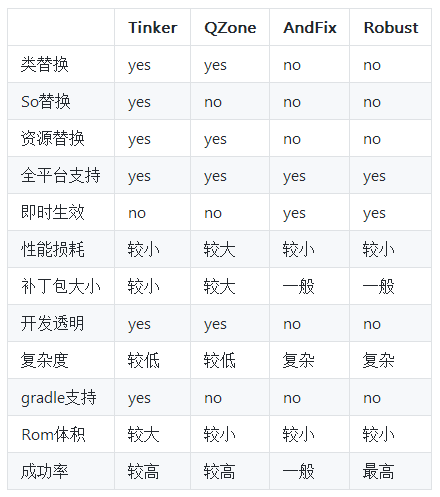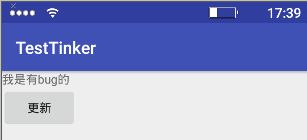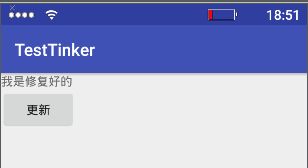Tinker是什么
Tinker是微信官方的Android热补丁解决方案,它支持动态下发代码、So库以及资源,让应用能够在不需要重新安装的情况下实现更新。当然,你也可以使用Tinker来更新你的插件。
它主要包括以下几个部分:
1、gradle编译插件: tinker-patch-gradle-plugin
2、核心sdk库: tinker-android-lib
3、非gradle编译用户的命令行版本: tinker-patch-cli.jar
为什么使用Tinker
热补丁:让应用能够在无需重新安装的情况实现更新,帮助应用快速建立动态修复能力。
从上面的定义来看,热补丁节省Android大量应用市场发布的时间。同时用户也无需重新安装,只要上线就能无感知的更新。看起来很美好,这是否可以意味我们可以尽量使用补丁来代替发布呢?事实上,热补丁技术当前依然存在它的局限性,主要表现在以下几点:
1、补丁只能针对单一客户端版本,随着版本差异变大补丁体积也会增大;
2、补丁不能支持所有的修改,例如AndroidManifest;
3、补丁无论对代码还是资源的更新成功率都无法达到100%。
既然补丁技术无法完全代替升级,那它适合使用在哪些场景呢?
一. 轻量而快速的升级
热补丁技术也可以理解为一个动态修改代码与资源的通道,它适合于修改量较少的情况。以微信的多次发布为例,补丁大小均在300K以内,它相对于传统的发布有着很大的优势。
以Android用户的升级习惯,即使是相对活跃的微信也需要10天以上的时间去覆盖50%的用户。使用补丁技术,我们能做到1天覆盖70%以上。这也是基于补丁体积较小,可以直接使用移动网络下载更新。
正因如此,补丁技术非常适合使用在灰度阶段。在过去,我们需要在正式发布前保证所有严重的问题都已经得到修复,这通常需要我们经过三次以上的灰度过程,而且无法快速的验证这些问题在同一批用户的修复效果。利用热补丁技术,我们可以快速对同一批用户验证修复效果,这大大缩短了我们的发布流程。
若发布版本出现问题或紧急漏洞,传统方式需要单独灰度验证修改,然后重新发布新的版本。利用补丁技术,我们只需要先上线小部分用户验证修改的效果,最后再全量上线即可。但是此种发布对线上用户影响较大, 我们需要谨慎而为。本着对用户负责的态度,发布补丁等同于发布版本,它也应该严格执行完整的测试与上线流程。
总的来说,补丁技术可以降低开发成本,缩短开发周期,实现轻量而快速的升级。
当前市面的热补丁方案有很多,其中比较出名的有阿里的AndFix、美团的Robust以及QZone的超级补丁方案。但它们都存在无法解决的问题,这也是正是我们推出Tinker的原因。
总的来说:
1、AndFix作为native解决方案,首先面临的是稳定性与兼容性问题,更重要的是它无法实现类替换,它是需要大量额外的开发成本的;
2、Robust兼容性与成功率较高,但是它与AndFix一样,无法新增变量与类只能用做的bugFix方案;
3、Qzone方案可以做到发布产品功能,但是它主要问题是插桩带来Dalvik的性能问题,以及为了解决Art下内存地址问题而导致补丁包急速增大的。
特别是在Android N之后,由于混合编译的inline策略修改,对于市面上的各种方案都不太容易解决。而Tinker热补丁方案不仅支持类、So以及资源的替换,它还是2.X-8.X(1.9.0以上支持8.X)的全平台支持。利用Tinker我们不仅可以用做bugfix,甚至可以替代功能的发布。Tinker已运行在微信的数亿Android设备上,那么为什么你不使用Tinker呢?
Tinker的已知问题
由于原理与系统限制,Tinker有以下已知问题:
1、Tinker不支持修改AndroidManifest.xml,Tinker不支持新增四大组件(1.9.0支持新增非export的Activity);
2、由于Google Play的开发者条款限制,不建议在GP渠道动态更新代码;
3、在Android N上,补丁对应用启动时间有轻微的影响;
4、不支持部分三星android-21机型,加载补丁时会主动抛 出"TinkerRuntimeException:checkDexInstall failed";
5、对于资源替换,不支持修改remoteView。例如transition动画,notification icon以及桌面图标。
如何使用Tinker
gradle接入
gradle是推荐的接入方式,在gradle插件tinker-patch-gradle-plugin中我们帮你完成proguard、multiDex以及Manifest处理等工作。
1、添加gradle依赖
在项目的build.gradle中,添加tinker-patch-gradle-plugin的依赖
buildscript {
dependencies {
classpath ('com.tencent.tinker:tinker-patch-gradle-plugin:1.9.1')
}
}
然后在app的gradle文件app/build.gradle,我们需要添加tinker的库依赖以及apply tinker的gradle插件.
dependencies {
//可选,用于生成application类
provided('com.tencent.tinker:tinker-android-anno:1.9.1')
//tinker的核心库
compile('com.tencent.tinker:tinker-android-lib:1.9.1')
}
...
...
//apply tinker插件
apply plugin: 'com.tencent.tinker.patch'
从微信提供的sample中的app/build.gradle中复制以下代码
defaultConfig {
applicationId "com.umfintech.testtinker"
minSdkVersion 15
targetSdkVersion 22
versionCode 1
versionName "1.0"
testInstrumentationRunner "android.support.test.runner.AndroidJUnitRunner"
//这里是第一步需要添加的
/**
* you can use multiDex and install it in your ApplicationLifeCycle implement
*/
multiDexEnabled true
/**
* buildConfig can change during patch!
* we can use the newly value when patch
*/
buildConfigField "String", "MESSAGE", "\"I am the base apk\""
// buildConfigField "String", "MESSAGE", "\"I am the patch apk\""
/**
* client version would update with patch
* so we can get the newly git version easily!
*/
buildConfigField "String", "TINKER_ID", "\"${getTinkerIdValue()}\""
buildConfigField "String", "PLATFORM", "\"all\""
//这里是第一步需要添加的
}
下面这些代码放到最外层
//第二步添加
def gitSha() {
try {
String gitRev = 'git rev-parse --short HEAD'.execute(null, project.rootDir).text.trim()
if (gitRev == null) {
throw new GradleException("can't get git rev, you should add git to system path or just input test value, such as 'testTinkerId'")
}
return gitRev
} catch (Exception e) {
throw new GradleException("can't get git rev, you should add git to system path or just input test value, such as 'testTinkerId'")
}
}
def bakPath = file("${buildDir}/bakApk/")
/**
* you can use assembleRelease to build you base apk
* use tinkerPatchRelease -POLD_APK= -PAPPLY_MAPPING= -PAPPLY_RESOURCE= to build patch
* add apk from the build/bakApk
*/
ext {
//for some reason, you may want to ignore tinkerBuild, such as instant run debug build?
tinkerEnabled = true
//for normal build
//old apk file to build patch apk
tinkerOldApkPath = "${bakPath}/app-debug-1018-17-32-47.apk"
//proguard mapping file to build patch apk
tinkerApplyMappingPath = "${bakPath}/app-debug-1018-17-32-47-mapping.txt"
//resource R.txt to build patch apk, must input if there is resource changed
tinkerApplyResourcePath = "${bakPath}/app-debug-1018-17-32-47-R.txt"
//only use for build all flavor, if not, just ignore this field
tinkerBuildFlavorDirectory = "${bakPath}/app-1018-17-32-47"
}
def getOldApkPath() {
return hasProperty("OLD_APK") ? OLD_APK : ext.tinkerOldApkPath
}
def getApplyMappingPath() {
return hasProperty("APPLY_MAPPING") ? APPLY_MAPPING : ext.tinkerApplyMappingPath
}
def getApplyResourceMappingPath() {
return hasProperty("APPLY_RESOURCE") ? APPLY_RESOURCE : ext.tinkerApplyResourcePath
}
//第三步注销此方法
def getTinkerIdValue() {
return hasProperty("TINKER_ID") ? TINKER_ID : gitSha()
}
def buildWithTinker() {
return hasProperty("TINKER_ENABLE") ? TINKER_ENABLE : ext.tinkerEnabled
}
def getTinkerBuildFlavorDirectory() {
return ext.tinkerBuildFlavorDirectory
}
if (buildWithTinker()) {
apply plugin: 'com.tencent.tinker.patch'
tinkerPatch {
/**
* necessary,default 'null'
* the old apk path, use to diff with the new apk to build
* add apk from the build/bakApk
*/
oldApk = getOldApkPath()
/**
* optional,default 'false'
* there are some cases we may get some warnings
* if ignoreWarning is true, we would just assert the patch process
* case 1: minSdkVersion is below 14, but you are using dexMode with raw.
* it must be crash when load.
* case 2: newly added Android Component in AndroidManifest.xml,
* it must be crash when load.
* case 3: loader classes in dex.loader{} are not keep in the main dex,
* it must be let tinker not work.
* case 4: loader classes in dex.loader{} changes,
* loader classes is ues to load patch dex. it is useless to change them.
* it won't crash, but these changes can't effect. you may ignore it
* case 5: resources.arsc has changed, but we don't use applyResourceMapping to build
*/
ignoreWarning = false
/**
* optional,default 'true'
* whether sign the patch file
* if not, you must do yourself. otherwise it can't check success during the patch loading
* we will use the sign config with your build type
*/
useSign = true
/**
* optional,default 'true'
* whether use tinker to build
*/
tinkerEnable = buildWithTinker()
/**
* Warning, applyMapping will affect the normal android build!
*/
buildConfig {
/**
* optional,default 'null'
* if we use tinkerPatch to build the patch apk, you'd better to apply the old
* apk mapping file if minifyEnabled is enable!
* Warning:
* you must be careful that it will affect the normal assemble build!
*/
applyMapping = getApplyMappingPath()
/**
* optional,default 'null'
* It is nice to keep the resource id from R.txt file to reduce java changes
*/
applyResourceMapping = getApplyResourceMappingPath()
/**
* necessary,default 'null'
* because we don't want to check the base apk with md5 in the runtime(it is slow)
* tinkerId is use to identify the unique base apk when the patch is tried to apply.
* we can use git rev, svn rev or simply versionCode.
* we will gen the tinkerId in your manifest automatic
*/
tinkerId = getTinkerIdValue()
/**
* if keepDexApply is true, class in which dex refer to the old apk.
* open this can reduce the dex diff file size.
*/
keepDexApply = false
/**
* optional, default 'false'
* Whether tinker should treat the base apk as the one being protected by app
* protection tools.
* If this attribute is true, the generated patch package will contain a
* dex including all changed classes instead of any dexdiff patch-info files.
*/
isProtectedApp = false
/**
* optional, default 'false'
* Whether tinker should support component hotplug (add new component dynamically).
* If this attribute is true, the component added in new apk will be available after
* patch is successfully loaded. Otherwise an error would be announced when generating patch
* on compile-time.
*
* Notice that currently this feature is incubating and only support NON-EXPORTED Activity
*/
supportHotplugComponent = false
}
dex {
/**
* optional,default 'jar'
* only can be 'raw' or 'jar'. for raw, we would keep its original format
* for jar, we would repack dexes with zip format.
* if you want to support below 14, you must use jar
* or you want to save rom or check quicker, you can use raw mode also
*/
dexMode = "jar"
/**
* necessary,default '[]'
* what dexes in apk are expected to deal with tinkerPatch
* it support * or ? pattern.
*/
pattern = ["classes*.dex",
"assets/secondary-dex-?.jar"]
/**
* necessary,default '[]'
* Warning, it is very very important, loader classes can't change with patch.
* thus, they will be removed from patch dexes.
* you must put the following class into main dex.
* Simply, you should add your own application {@code tinker.sample.android.SampleApplication}
* own tinkerLoader, and the classes you use in them
*
*/
loader = [
//use sample, let BaseBuildInfo unchangeable with tinker
"tinker.sample.android.app.BaseBuildInfo"
]
}
lib {
/**
* optional,default '[]'
* what library in apk are expected to deal with tinkerPatch
* it support * or ? pattern.
* for library in assets, we would just recover them in the patch directory
* you can get them in TinkerLoadResult with Tinker
*/
pattern = ["lib/*/*.so"]
}
res {
/**
* optional,default '[]'
* what resource in apk are expected to deal with tinkerPatch
* it support * or ? pattern.
* you must include all your resources in apk here,
* otherwise, they won't repack in the new apk resources.
*/
pattern = ["res/*", "assets/*", "resources.arsc", "AndroidManifest.xml"]
/**
* optional,default '[]'
* the resource file exclude patterns, ignore add, delete or modify resource change
* it support * or ? pattern.
* Warning, we can only use for files no relative with resources.arsc
*/
ignoreChange = ["assets/sample_meta.txt"]
/**
* default 100kb
* for modify resource, if it is larger than 'largeModSize'
* we would like to use bsdiff algorithm to reduce patch file size
*/
largeModSize = 100
}
packageConfig {
/**
* optional,default 'TINKER_ID, TINKER_ID_VALUE' 'NEW_TINKER_ID, NEW_TINKER_ID_VALUE'
* package meta file gen. path is assets/package_meta.txt in patch file
* you can use securityCheck.getPackageProperties() in your ownPackageCheck method
* or TinkerLoadResult.getPackageConfigByName
* we will get the TINKER_ID from the old apk manifest for you automatic,
* other config files (such as patchMessage below)is not necessary
*/
configField("patchMessage", "tinker is sample to use")
/**
* just a sample case, you can use such as sdkVersion, brand, channel...
* you can parse it in the SamplePatchListener.
* Then you can use patch conditional!
*/
configField("platform", "all")
/**
* patch version via packageConfig
*/
configField("patchVersion", "1.0")
}
//or you can add config filed outside, or get meta value from old apk
//project.tinkerPatch.packageConfig.configField("test1", project.tinkerPatch.packageConfig.getMetaDataFromOldApk("Test"))
//project.tinkerPatch.packageConfig.configField("test2", "sample")
/**
* if you don't use zipArtifact or path, we just use 7za to try
*/
sevenZip {
/**
* optional,default '7za'
* the 7zip artifact path, it will use the right 7za with your platform
*/
zipArtifact = "com.tencent.mm:SevenZip:1.1.10"
/**
* optional,default '7za'
* you can specify the 7za path yourself, it will overwrite the zipArtifact value
*/
// path = "/usr/local/bin/7za"
}
}
List flavors = new ArrayList<>();
project.android.productFlavors.each { flavor ->
flavors.add(flavor.name)
}
boolean hasFlavors = flavors.size() > 0
def date = new Date().format("MMdd-HH-mm-ss")
/**
* bak apk and mapping
*/
android.applicationVariants.all { variant ->
/**
* task type, you want to bak
*/
def taskName = variant.name
tasks.all {
if ("assemble${taskName.capitalize()}".equalsIgnoreCase(it.name)) {
it.doLast {
copy {
def fileNamePrefix = "${project.name}-${variant.baseName}"
def newFileNamePrefix = hasFlavors ? "${fileNamePrefix}" : "${fileNamePrefix}-${date}"
def destPath = hasFlavors ? file("${bakPath}/${project.name}-${date}/${variant.flavorName}") : bakPath
from variant.outputs.first().outputFile
into destPath
rename { String fileName ->
fileName.replace("${fileNamePrefix}.apk", "${newFileNamePrefix}.apk")
}
from "${buildDir}/outputs/mapping/${variant.dirName}/mapping.txt"
into destPath
rename { String fileName ->
fileName.replace("mapping.txt", "${newFileNamePrefix}-mapping.txt")
}
from "${buildDir}/intermediates/symbols/${variant.dirName}/R.txt"
into destPath
rename { String fileName ->
fileName.replace("R.txt", "${newFileNamePrefix}-R.txt")
}
}
}
}
}
}
project.afterEvaluate {
//sample use for build all flavor for one time
if (hasFlavors) {
task(tinkerPatchAllFlavorRelease) {
group = 'tinker'
def originOldPath = getTinkerBuildFlavorDirectory()
for (String flavor : flavors) {
def tinkerTask = tasks.getByName("tinkerPatch${flavor.capitalize()}Release")
dependsOn tinkerTask
def preAssembleTask = tasks.getByName("process${flavor.capitalize()}ReleaseManifest")
preAssembleTask.doFirst {
String flavorName = preAssembleTask.name.substring(7, 8).toLowerCase() + preAssembleTask.name.substring(8, preAssembleTask.name.length() - 15)
project.tinkerPatch.oldApk = "${originOldPath}/${flavorName}/${project.name}-${flavorName}-release.apk"
project.tinkerPatch.buildConfig.applyMapping = "${originOldPath}/${flavorName}/${project.name}-${flavorName}-release-mapping.txt"
project.tinkerPatch.buildConfig.applyResourceMapping = "${originOldPath}/${flavorName}/${project.name}-${flavorName}-release-R.txt"
}
}
}
task(tinkerPatchAllFlavorDebug) {
group = 'tinker'
def originOldPath = getTinkerBuildFlavorDirectory()
for (String flavor : flavors) {
def tinkerTask = tasks.getByName("tinkerPatch${flavor.capitalize()}Debug")
dependsOn tinkerTask
def preAssembleTask = tasks.getByName("process${flavor.capitalize()}DebugManifest")
preAssembleTask.doFirst {
String flavorName = preAssembleTask.name.substring(7, 8).toLowerCase() + preAssembleTask.name.substring(8, preAssembleTask.name.length() - 13)
project.tinkerPatch.oldApk = "${originOldPath}/${flavorName}/${project.name}-${flavorName}-debug.apk"
project.tinkerPatch.buildConfig.applyMapping = "${originOldPath}/${flavorName}/${project.name}-${flavorName}-debug-mapping.txt"
project.tinkerPatch.buildConfig.applyResourceMapping = "${originOldPath}/${flavorName}/${project.name}-${flavorName}-debug-R.txt"
}
}
}
}
}
}
//第二步添加
复制完成之后同步Gradle,如果as没有安装git会报以下错误
can't get git rev, you should add git to system path or just input test value, such as 'testTinkerId'
官方文档默认是将git提交的记录作为think_id记录下来,这里我不需要,所以需要把第一步复制的
buildConfigField "String", "TINKER_ID", "\"${getTinkerIdValue()}\""
改成
buildConfigField "String", "TINKER_ID", "\"1.0\""
我直接写死,需要git提交记录作为tinker_id的也可以按照官方文档推荐的写
同时,这些地方也可以相应的替换掉
//第三步注销此方法
//def getTinkerIdValue() {
// return hasProperty("TINKER_ID") ? TINKER_ID : gitSha()
//}
tinkerId = "1.0"//getTinkerIdValue()
继续同步Gradle 完成
下面需要下载微信提供的Demo请参考tinker-sample-android
看来demo的app/build.gradl补充一下,需要配置签名和buildTypes同一级,buildTypes也需要修改一下,是为了debug运行的时候就可以直接测试了,添加proguardFiles getDefaultProguardFile('proguard-android.txt'), 'proguard-rules.pro'是为了debug运行也会生成mapping文件
signingConfigs {
release {
try {
storeFile file("./keystore/release.keystore")
storePassword "testres"
keyAlias "testres"
keyPassword "testres"
} catch (ex) {
throw new InvalidUserDataException(ex.toString())
}
}
debug {
storeFile file("./keystore/debug.keystore")
}
}
buildTypes {
release {
minifyEnabled true
signingConfig signingConfigs.release
proguardFiles getDefaultProguardFile('proguard-android.txt'), 'proguard-rules.pro'
}
debug {
debuggable true
minifyEnabled true
signingConfig signingConfigs.debug
proguardFiles getDefaultProguardFile('proguard-android.txt'), 'proguard-rules.pro'
}
}
这下面主要是设置生成的文件所在的目录是什么
/**
* 这下面主要是设置生成的文件所在的目录是什么
*/
android.applicationVariants.all { variant ->
/**
* task type, you want to bak
*/
def taskName = variant.name
tasks.all {
if ("assemble${taskName.capitalize()}".equalsIgnoreCase(it.name)) {
it.doLast {
copy {
def fileNamePrefix = "${project.name}-${variant.baseName}"
def newFileNamePrefix = hasFlavors ? "${fileNamePrefix}" : "${fileNamePrefix}-${date}"
def destPath = hasFlavors ? file("${bakPath}/${project.name}-${date}/${variant.flavorName}") : bakPath
from variant.outputs.first().outputFile
into destPath
rename { String fileName ->
fileName.replace("${fileNamePrefix}.apk", "${newFileNamePrefix}.apk")
}
from "${buildDir}/outputs/mapping/${variant.dirName}/mapping.txt"
into destPath
rename { String fileName ->
fileName.replace("mapping.txt", "${newFileNamePrefix}-mapping.txt")
}
from "${buildDir}/intermediates/symbols/${variant.dirName}/R.txt"
into destPath
rename { String fileName ->
fileName.replace("R.txt", "${newFileNamePrefix}-R.txt")
}
}
}
}
}
}
配置完上面之后,build就配置好了,接下来配置application
先上代码
@DefaultLifeCycle(application =.AppContext",
flags = ShareConstants.TINKER_ENABLE_ALL,
loadVerifyFlag =true)
public class SimpleTinkerInApplicationLike extends ApplicationLike {
public SimpleTinkerInApplicationLike(Application application, int tinkerFlags, boolean tinkerLoadVerifyFlag, long applicationStartElapsedTime, long applicationStartMillisTime, Intent tinkerResultIntent) {
super(application, tinkerFlags, tinkerLoadVerifyFlag, applicationStartElapsedTime, applicationStartMillisTime, tinkerResultIntent);
}
@Override
public void onBaseContextAttached(Context base) {
super.onBaseContextAttached(base);
MultiDex.install(base);
TinkerInstaller.install(this);
}
@Override
public void onCreate() {
super.onCreate();
}
}
代码中AppContextLike继承了ApplicationLike,而ApplicationLike并非集成Application,而是类似于Application的一个类。Tinker建议编写一个ApplicationLike的子类,可以当做Application使用,注意顶部的注解:@DefaultLifeCycle,其application属性,会在编译期生成一个.AppContext类。所以我们在AndroidManifest.xml中的application标签下这样写:
写完后会报红,此时只需要Build下即可解决报红。Application配置就到此结束。接下来生成patch文件。因为patch文件是写入到SDCrad的,所以我们需要在AndroidManifest中添加如下权限(注: 6.0及已上系统请动态设置权限或者手动在设置中为项目设置):
接下看下我的测试代码 简化版本
MainActivity 6.0以上权限没有处理
public class MainActivity extends AppCompatActivity {
@Override
protected void onCreate(Bundle savedInstanceState) {
super.onCreate(savedInstanceState);
setContentView(R.layout.activity_main);
}
//加载补丁
public void loadPath(View view) {
loadApk();
}
public void loadApk() {
String path = Environment.getExternalStorageDirectory().getAbsolutePath() + "/patch_signed_7zip.apk";
File file = new File(path);
if (file.exists()) {
Toast.makeText(this, "补丁已经存在", Toast.LENGTH_SHORT).show();
TinkerInstaller.onReceiveUpgradePatch(getApplicationContext(), path);
Log.d("swy", path);
} else {
Toast.makeText(this, "补丁已经不存在", Toast.LENGTH_SHORT).show();
Log.d("swy", path);
}
}
}
然后直接运行APP ,前面修改debug混淆就是为了现在可以直接运行测试
会生成如下的目录结构
界面效果
现在安装到设备里面的就可以理解为是有问题的程序,接下来修改app的gradle文件app/build.gradle把刚才生成的文件名字复制下面相应的位置
ext {
//是否打开tinker的功能
//for some reason, you may want to ignore tinkerBuild, such as instant run debug build?
tinkerEnabled = true
//基准apk包的路径,必须输入,否则会报错
//for normal build
//old apk file to build patch apk
tinkerOldApkPath = "${bakPath}/app-debug-1221-17-09-55.apk"
//可选参数;在编译新的apk时候,我们希望通过保持旧apk的proguard混淆方式,从而减少补丁包的大小。
//这个只是推荐设置,不设置applyMapping也不会影响任何的assemble编译。
tinkerApplyMappingPath = "${bakPath}/app-debug-1221-17-09-55-mapping.txt"
//可选参数;在编译新的apk时候,我们希望通过旧apk的R.txt文件保持ResId的分配,
//这样不仅可以减少补丁包的大小,同时也避免由于ResId改变导致remote view异常。
tinkerApplyResourcePath = "${bakPath}/app-debug-1221-17-09-55-R.txt"
//only use for build all flavor, if not, just ignore this field
tinkerBuildFlavorDirectory = "${bakPath}/app-1018-17-32-47"
}
修改之后就去修改错误代码了,把之前android:text="我是有bug的"修改成android:text="我是修复好的",修改完之后生成补丁包如下图,由于我是已debug做测试,所以我也生成debug的补丁包,注意这里是debug版本,不能debug版本,release版本混着来,比如oldapk是debug版本,新的apk是release版本,这样是不行的,统一用release或debug版本
生成目录如下
把patch_signed_7zip.apk这个文件拷贝的手机的sd卡中,模拟是下载到手机当中,点击应用中的更新按钮,处理逻辑可以查看上面之前贴的代码,更新之后会关闭成,我们看下是否成功
可以看到已经是变成咱们修复好的了,到此为止已经可以实现最简单的修复了,下篇文章咱们讲解一下如果放到自己的商用项目中需要做些什么工作的。最后感谢下面几篇参考文章的作者!
参考文章:https://github.com/Tencent/tinker/wiki/Tinker-%E6%8E%A5%E5%85%A5%E6%8C%87%E5%8D%97
http://blog.csdn.net/qq_15527709/article/details/61921447
http://www.jianshu.com/p/d50817b6d622








